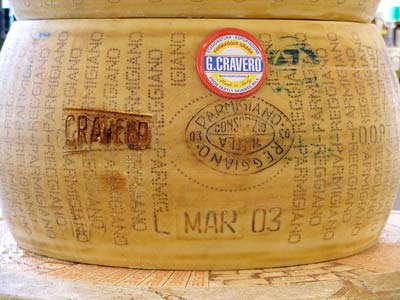Parmesan cheese (PDO). A well-known, high quality, very hard, grana cow's milk cheese from Modena, made around Parma since the 17th in its present form, and recorded as early as the Decameron in the 14th C. It has a brittle amber coloured paste with white speckles and flakes called snowflakes. It is made in an 18 month process unchanged for 3 centuries. Parmigiano Reggiano is the authentic one, like the difference between Brie de Meaux and Brie. It is made in barrel shapes weighing 35 kg (77 lb), which are salted and which bear the name and date etched in perforated lettering on a light brown rind. Only about 2½ million are made each year. It has no additives other than salt and rennet.
Depending on when it is made throughout the year it will be labelled in different ways, so that 'maggengo' means from April to November or 'invernengo' from December to March. The maggengo period can be split still further into 'ditesta' meaning from April to June, 'agostano' or 'di centro' from July to August and 'tardno' from September to November. As with other cheeses, 'vecchio' indicates that a cheese is one to two years old and 'stravecchio' means two to three years old. Always look for cheeses stamped with the full name 'Parmigiano Reggiano'. The finest quality are stampled for export.
A ruling in June 2002 at the European Court of Justice in Luxembourg dictated that cheeses labelled Parmesan or Parmigiano-Reggiano must be made from milk collected within 75 km of Modena, from cows that graze in the vicinity of Parma and Reggio-Emilia and other closely related regions, must comply with a traditional recipe and must be aged for one to three years.The recipe includes the requirement for whole milk from the morning milking to be mixed with semi-skimmed milk from the evening before.
Parmigiano Reggiano or Parmesan cheese is widely used in Italian cooking and for grating over pasta dishes, salads and risotti. Traditionally the cheese is broken open, or split in two and then further into sections. There are various unwritten rules about Parmesan, such as Parmesan should not be incorporated with a seafood dish which includes pasta or rice, but these are increasingly disregarded. Other grana versions are Iodigiano and Granapadano.
When buying Parmesan cheese look at the point where the paste joins the rind. There should be a steady progression in the gradation of the colour change. A white line indicates that it has been badly stored. If the band is very broad it is dehydrated. Chalky white patches also show that it is dehydrated. Moisten a piece of cheesecloth, wring it out and then wrap it around the cheese. Sprinkle it with a little more water and refrigerate for two days. Then unwrap it and store it. To store, wrap it in wax paper and then in aluminium foil and put in the lowest shelf available. Don’t use cling film.
Samuel Pepys held the cheese in such high esteem that, when the Great Fire of London approached his property, he buried a Parmesan cheese in the ground.
